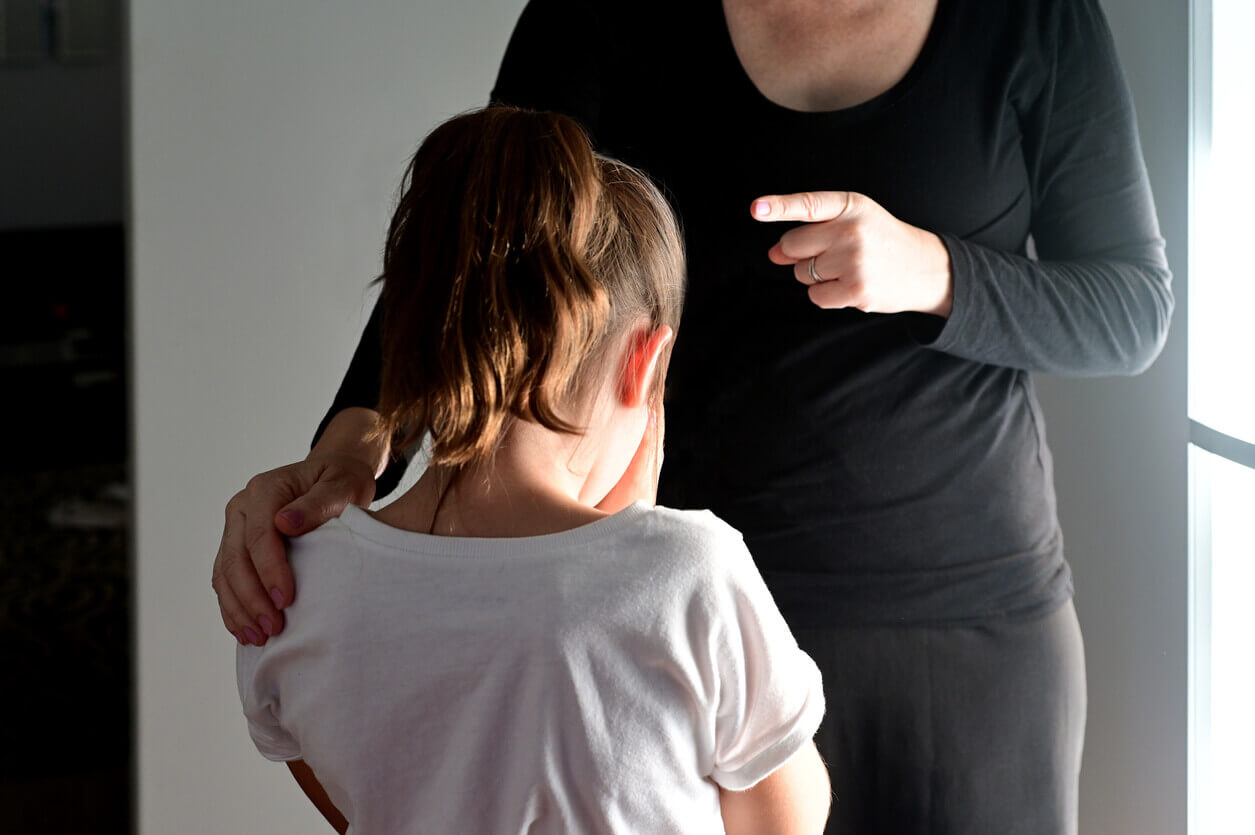Dealing with Mood Swings in Children


Written and verified by the psychologist Maria Fátima Seppi Vinuales
Sometimes, living together at home can be complicated. Each member of the family has their own situations and challenges, and in our daily encounters, we have to make all these “moods” co-exist. It happens that many times, we don’t know how to deal with mood swings in children, and we end up being trapped in that same state of mind, instead of offering another answer. Sometimes, this even leads to a major argument or anger. Let’s see what we can do.
About emotions and mood swings in children
Many times, when thinking about our children’s mood swings, we get “stuck” in that unpleasant, conflicting, and/or argumentative situation. However, from an early age, it’s important to start by validating and recognizing that life has its nuances. Some days are harder than others.
It’s important to educate little ones on emotional intelligence in order to help them become aware of their emotions while also helping them to manage them. It’s not about promoting “perpetual happiness”, but about finding the best and healthiest ways to express and share what we feel.
How to deal with mood swings in children
Some of the recommendations that you can take into account to deal with mood changes in children without losing your temper are the following:
- To deal with your child’s mood swings, it’s important to situate yourself in the situation. Why are they in a bad mood? Perhaps something has happened at school and they don’t know how to deal with it or they can’t process it yet. It’s important to recognize that all emotions, both those that we identify as pleasant – such as joy – and those that are unpleasant – such as anger – are an attempt to communicate something to us. That is, by paying attention to them, we can learn from them and do something to change.

- On the other hand, we must also take into account the age of the child. When they’re younger, their emotional intelligence is still developing. In addition, their emotions are the vehicle through which they can ask for what they need: For example, they cry to express that they’re sleepy or hungry. It’s therefore possible that they often feel like “prisoners” of their emotions. On the contrary, in adolescence, mood swings are due to this complex process of self-affirmation and search for identity.
- Apply an assertive response. Whether or not you feel like your child’s bad mood is justified, if you yell at them or get even angrier, they won’t calm down. After all, don’t you feel the same way? What we all need at this time is a little peace and quiet to regain our balance. So, you can ask them what they need to feel better. Time? A hug? A talk? A moment alone? Sometimes it’s even a matter of simply listening to them and allowing them to express themselves: This “catharsis” is liberating in and of itself.
- Help them think about how they can resolve what’s happening to them. Bringing a different perspective can make everything simpler and seem less catastrophic. This doesn’t mean invalidating their emotions or concerns, but we can help them approach the problem from a different place.
- You can also help them notice the change that occurs when we set out to do our tasks in a better mood. This doesn’t mean not giving way to being in a bad mood one day. But it’s a way of pointing out the way everything flows easier or faster when our disposition changes.

- Be flexible. If your child had a bad day at school or had an argument with a friend, then that day you can tell him that they don’t have to tidy up their room but they can do it the next day. Or, you can suggest cooking their favorite dish to lift their spirits. If you would do the same with a friend who’s going through a bad time, why not practice it at home?
You may be interested in: Disruptive Mood Dysregulation Disorder in Children
Looking at ourselves
At the same time, it’s also worth thinking about how we are as adults in our parenting. Sometimes looking at our children also serves as a mirror: Do we expect them to be in a good mood when we’re incapable of it ourselves? Do we “pollute” a weekend lunch by taking work calls? What’s our parenting style like? Being too rigid or authoritarian also influences the way they react.
Regarding the emotional climate of your family, it’s important to know how to recognize that there are good and bad days and that it’s logical to experience different emotions. But it’s also necessary to be respectful of our children and the rest of the people who live with us, as we affect the daily coexistence. We should ask for help or look for healthier ways to face our conflicts instead of constantly complaining or being in a bad mood. Being a good example and learning together with them to control our emotions is an excellent starting point.
Sometimes, living together at home can be complicated. Each member of the family has their own situations and challenges, and in our daily encounters, we have to make all these “moods” co-exist. It happens that many times, we don’t know how to deal with mood swings in children, and we end up being trapped in that same state of mind, instead of offering another answer. Sometimes, this even leads to a major argument or anger. Let’s see what we can do.
About emotions and mood swings in children
Many times, when thinking about our children’s mood swings, we get “stuck” in that unpleasant, conflicting, and/or argumentative situation. However, from an early age, it’s important to start by validating and recognizing that life has its nuances. Some days are harder than others.
It’s important to educate little ones on emotional intelligence in order to help them become aware of their emotions while also helping them to manage them. It’s not about promoting “perpetual happiness”, but about finding the best and healthiest ways to express and share what we feel.
How to deal with mood swings in children
Some of the recommendations that you can take into account to deal with mood changes in children without losing your temper are the following:
- To deal with your child’s mood swings, it’s important to situate yourself in the situation. Why are they in a bad mood? Perhaps something has happened at school and they don’t know how to deal with it or they can’t process it yet. It’s important to recognize that all emotions, both those that we identify as pleasant – such as joy – and those that are unpleasant – such as anger – are an attempt to communicate something to us. That is, by paying attention to them, we can learn from them and do something to change.

- On the other hand, we must also take into account the age of the child. When they’re younger, their emotional intelligence is still developing. In addition, their emotions are the vehicle through which they can ask for what they need: For example, they cry to express that they’re sleepy or hungry. It’s therefore possible that they often feel like “prisoners” of their emotions. On the contrary, in adolescence, mood swings are due to this complex process of self-affirmation and search for identity.
- Apply an assertive response. Whether or not you feel like your child’s bad mood is justified, if you yell at them or get even angrier, they won’t calm down. After all, don’t you feel the same way? What we all need at this time is a little peace and quiet to regain our balance. So, you can ask them what they need to feel better. Time? A hug? A talk? A moment alone? Sometimes it’s even a matter of simply listening to them and allowing them to express themselves: This “catharsis” is liberating in and of itself.
- Help them think about how they can resolve what’s happening to them. Bringing a different perspective can make everything simpler and seem less catastrophic. This doesn’t mean invalidating their emotions or concerns, but we can help them approach the problem from a different place.
- You can also help them notice the change that occurs when we set out to do our tasks in a better mood. This doesn’t mean not giving way to being in a bad mood one day. But it’s a way of pointing out the way everything flows easier or faster when our disposition changes.

- Be flexible. If your child had a bad day at school or had an argument with a friend, then that day you can tell him that they don’t have to tidy up their room but they can do it the next day. Or, you can suggest cooking their favorite dish to lift their spirits. If you would do the same with a friend who’s going through a bad time, why not practice it at home?
You may be interested in: Disruptive Mood Dysregulation Disorder in Children
Looking at ourselves
At the same time, it’s also worth thinking about how we are as adults in our parenting. Sometimes looking at our children also serves as a mirror: Do we expect them to be in a good mood when we’re incapable of it ourselves? Do we “pollute” a weekend lunch by taking work calls? What’s our parenting style like? Being too rigid or authoritarian also influences the way they react.
Regarding the emotional climate of your family, it’s important to know how to recognize that there are good and bad days and that it’s logical to experience different emotions. But it’s also necessary to be respectful of our children and the rest of the people who live with us, as we affect the daily coexistence. We should ask for help or look for healthier ways to face our conflicts instead of constantly complaining or being in a bad mood. Being a good example and learning together with them to control our emotions is an excellent starting point.
All cited sources were thoroughly reviewed by our team to ensure their quality, reliability, currency, and validity. The bibliography of this article was considered reliable and of academic or scientific accuracy.
- Salguero, M. J. C. (2011). Importancia de la inteligencia emocional como contribución al desarrollo integral de los niños/as de educación infantil. Pedagogía magna, (11), 178-188.
- Cruz, P. C. (2014). Creatividad e Inteligencia Emocional.(Como desarrollar la competencia emocional, en Educación Infantil, a través de la expresión lingüística y corporal). Historia y comunicación social, 19, 107-118.
This text is provided for informational purposes only and does not replace consultation with a professional. If in doubt, consult your specialist.








